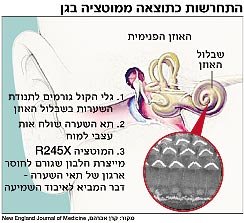Asher syndrome type 1 was diagnosed among Jews in Berlin as early as 1861, now the R245X mutation that causes it has been identified
Merit Sloin

Deafening process may be caused by several factors. They can be environmental, genetic or both. According to an estimate, about half of the cases of deafness in childhood are hereditary, and result from a certain change - a mutation - in one of the 100 genes involved in the hearing process. In addition, there are mutations that do not directly cause hearing impairment, but increase the chance of becoming deaf due to environmental factors such as exposure to noise.
So far six genes have been found in Israelis that are related to deafness. The most common among them is "Connexin 26" whose mutation causes about a third of the cases of deafness in Israel.
Sometimes deafness is only part of the problem, and it is accompanied by damage to other senses such as sight. The New England Journal of Medicine reports today on the discovery of a mutation in the PCDH15 gene called R245X that causes deafness in both ears and gradual loss of vision due to retinal degeneration. The symptoms caused by the mutation are called Asher type 1 syndrome, which is characterized by congenital deafness and gradual blindness beginning in the second decade of life. Today, five genes are known that are responsible for the appearance of the syndrome when a mutation occurs in them.
R245X appears only in the Ashkenazi population, about 1% of which carry it. The type 1 syndrome was diagnosed among Jews as early as 1861 by a doctor in Berlin, and today - 142 years later - the genetic defect that causes it has been identified.
The R245X mutation was discovered as a result of a collaboration between researchers from four institutions: Prof. Keren Avraham from the Faculty of Medicine at Tel Aviv University; Researchers from the School of Medicine of the Mount Sinai Hospital in New York; researchers from New York University Medical Center; and scientists from the National Institute on Deafness and Communication Disorders (NIDCD) in Maryland.
Dr. Thomas Friedman and Dr. Tamar Ben-Yosef from NIDCD identified the mutation in the American and Israeli Ashkenazi population. "A syndrome that was identified among other denominations besides Ashkenazim," says Avraham. "The new findings do not indicate that its prevalence is higher in the Ashkenazi population, but only that today it can be identified in a significant portion of Asher syndrome patients who are Ashkenazi." In testing DNA samples of deaf people in Prof. Avraham's laboratory, several families were found in which the disease was caused by the mutation and they were informed about it. The carriers, who have one normal copy of the gene and a second damaged copy, do not develop the disease, but can pass the damaged gene to their children.
The normal gene, "PCDH15, encodes a protein that functions in the eye and ear, where it is involved in the spatial organization of the hair cells. These cells are in the inner ear, in an organ called the cochlea, and receive the sound waves. The sound waves that reach the cochlea cause hairs to vibrate, and as a result, the hair cell sends a nerve signal that reaches the brain. Different frequencies of sound waves cause hairs to vibrate in different areas of the cochlea, and this is how the distinction between sounds is made.
When the gene is damaged, it produces a defective protein that causes disorganization of the hair cells. When a mutation is induced in mice, it is seen that the hair cells are not organized properly, and the mice become deaf.
In addition to the possible damage to hearing, damage to the gene causes the development of blindness, as a result of damage to the retina - a disease called "retinitis pigmentosa". It is possible that the defective protein is also responsible for retinal degeneration, but it is not yet known how it causes blindness.
"Identifying the mutation and its prevalence in the Ashkenazi population has important diagnostic and rehabilitative implications," says Prof. Moshe Friedman from the Genetic Institute at Sheba Hospital. "Diagnosis at a stage when there are still no visual impairments, will allow children to be given communication skills before the vision deteriorates."
They knew innovations in medicine
https://www.hayadan.org.il/BuildaGate4/general2/data_card.php?Cat=~~~505934803~~~25&SiteName=hayadan
